This article was medically reviewed by Daniel Wozniczka, MD, MPH. Dr. Wozniczka is an Internal Medicine Physician, who is focused on the intersection of medicine, economics, and policy. He has global healthcare experience in Sub Saharan Africa, Eastern Europe, and Southeast Asia. He serves currently as a Lieutenant Commander in the U.S. Public Health Service and a Medical Officer for the Epidemic Intelligence Service in the CDC. He completed his MD at Jagiellonian University in 2014, and also holds an MBA and Masters in Public Health from the University of Illinois at Chicago.
wikiHow marks an article as reader-approved once it receives enough positive feedback. This article received 20 testimonials and 91% of readers who voted found it helpful, earning it our reader-approved status.
This article has been viewed 846,554 times.
If someone is choking, it's important you know what to do to help. The Heimlich maneuver (abdominal thrusts) is an emergency response technique that can save a life in seconds. It is a simple action that will often dislodge food or another object from a person's airway when they are choking, as it provides an increase in pressure in the abdomen and chest, enabling the object to be expelled.[1]
Steps
Performing the Heimlich on a Standing Person
-
1Determine if the person is truly choking. A choking victim will often have their hands around their throat. If you notice someone making this gesture, look for other choking signals. You should only perform the Heimlich on a choking person. Look for the following:[2]
- Cannot breathe or experiencing loud, difficult breathing
- Cannot speak
- Inability to cough effectively
- Blue or gray color to lips and fingernail beds
- Loss of consciousness
-
2Let the person know you're going to perform the Heimlich. Tell the choking person you want to help them. Let them know you know the Heimlich Maneuver and are going to perform it on them.Advertisement
-
3Wrap your arms around the person's waist. Stand with your legs separated to best support your body. Gently wrap both arms around their waist. Lean them forward slightly.[3]
-
4Position your hands. With one hand, make a fist. Which hand you use does not matter. Position your fist below the ribcage, but above the navel. Then, wrap your other hand around your fist.
-
5Make a series of thrusts. To make a thrust, press hard and quick into the abdomen. Pull inward and upward as you press. It should feel like you're trying to lift the person off the ground.[4]
- Make the thrusts quick and forceful.
- Perform five abdominal thrusts in quick succession. If the object is still not dislodged, repeat with five additional thrusts.
-
6Perform back blows. If the object is not dislodged with the Heimlich maneuver, do back blows. Deliver five blows to the person's back with the heel of your hand. Aim for the area between the shoulder blades.
- Press down hard, as you need to use enough force to dislodge the object.[5] However, keep the force confined to your hands. Do not squeeze the area surrounding the person's ribcage or abdomen.
-
7Call emergency services. Call emergency services if the object is not dislodged. Preferably, have someone else call emergency services after the Heimlich fails the first time and you are performing another round of back blows. When an emergency service worker arrives, they can get the object dislodged. At this point, stay away from the choking person.[6]
Performing the Heimlich on Someone Lying Down
-
1Get the person on their back. If you can't wrap your arms around the person, or if they've fallen, get them on their back. Gently instruct the person to turn on their back and help them as necessary.[7]
-
2Kneel at the person's hips. Get on you knees and position yourself on top of the person. Kneel over the person, hovering just above their hips.[8]
-
3Position your hands. Place one hand on top of the other. Place the heel of the bottom hand on the person's abdomen. This is the area just below the ribcage but above the navel.[9]
-
4Press your hands on the person's abdomen. Using your bodyweight, press your hands into the person's abdomen with a slight upward motion. Repeat doing thrusts until the object is expelled from the person's throat.[10]
-
5Call emergency services. If you're unable to expel the object using the Heimlich, call emergency services. If someone is choking and you are unable to help, medical professionals will be needed to remove the unwanted object. When they arrive, answer any questions they have and allow them to help the person.
Performing the Heimlich on an Infant
-
1Hold the infant face down. To start, find a firm surface. Lay the infant on the firm surface with their face down. Make sure the infant's head is turned so they can breathe. Kneel near the infant's feet.[11]
- You can also place the infant on your lap face down.
-
2Give the baby five quick blows to the back. Use the heel of your hand. Deliver five quick blows to the area between the infant's shoulder blades. Hopefully, an object will pop out quickly.[12]
- With an infant, be firm in the blows but do not use harsh force. You do not want to press too hard, as this could hurt an infant. Gravity combined with back blows can provide adequate force to dislodge the object.[13]
-
3Turn the infant over. If no object pops out, turn the infant over. Support their head with your hand, keeping the head slightly lower than the feet.[14]
-
4Give the infant five chest thrusts. Place your fingers on the lower half of the infant's breastbone. Make sure to keep your hand in the middle of your infant's breastbone and not to one side of another. Press down five times in a series of chest thrusts. If you see the object become dislodged, stop giving chest thrusts.[15]
-
5Call emergency services if the objects fails to come out. Immediately call 9-1-1 if the object does not become dislodged. As you wait, repeat the back blows and the chest thrusts. Repeating the steps may cause the object to become dislodged while you're waiting.[16]
Performing the Heimlich on Yourself
-
1Make a fist. To start, make a firm fist with your hand. It does not matter which hand you're using.
-
2Press your fist against your abdomen. Place the thumb side of your fist against your abdomen. Your hand should be below the ribcage, but above the navel. Wrap your other hand around your fist.
-
3Press against your abdomen. Press your hands in your abdomen. Do so over and over again until the object is dislodged. Use quick, upward thrusts as you attempt to dislodge the object.
-
4See a physician. You should see a doctor after saving yourself from choking. They will want to make sure there was no damage. You should also call 9-1-1 or go to the ER if you are choking and cannot dislodge the object.
Warnings
- If you do not know what to do, call your local emergency number. They can help to talk you through treating the victim (put them on loudspeaker).⧼thumbs_response⧽
- Choking is life-threatening. Be prepared to act immediately if someone is experiencing this.⧼thumbs_response⧽
- Do not attempt to slap a choking victim on the back if he or she is coughing! A coughing victim indicates only a partial blockage, and slapping one on the back can induce a full air blockage by lodging the object farther down. Allow him or her to cough up the blockage or show signs of choking before you intervene.⧼thumbs_response⧽
References
- ↑ http://www.mayoclinic.org/first-aid/first-aid-choking/basics/art-20056637
- ↑ http://www.mayoclinic.org/first-aid/first-aid-choking/basics/art-20056637
- ↑ http://www.mayoclinic.org/first-aid/first-aid-choking/basics/art-20056637
- ↑ http://www.mayoclinic.org/first-aid/first-aid-choking/basics/art-20056637
- ↑ http://www.mayoclinic.org/first-aid/first-aid-choking/basics/art-20056637
- ↑ http://www.mayoclinic.org/first-aid/first-aid-choking/basics/art-20056637
- ↑ https://www.webmd.com/first-aid/video/how-to-heimlich-maneuver
- ↑ https://www.webmd.com/first-aid/video/how-to-heimlich-maneuver
- ↑ https://www.webmd.com/first-aid/video/how-to-heimlich-maneuver
- ↑ https://www.webmd.com/first-aid/video/how-to-heimlich-maneuver
- ↑ https://www.drugs.com/cg/performing-the-heimlich-maneuver.html
- ↑ http://www.parenting.com/article/how-to-do-the-heimlich-maneuver-on-your-child
- ↑ http://www.mayoclinic.org/first-aid/first-aid-choking/basics/art-20056637
- ↑ https://www.drugs.com/cg/performing-the-heimlich-maneuver.html
- ↑ https://www.drugs.com/cg/performing-the-heimlich-maneuver.html
- ↑ https://www.drugs.com/cg/performing-the-heimlich-maneuver.html
About This Article
To perform the Heimlich maneuver on a person who is choking, stand behind them with your feet apart, and wrap your arms around their waist. Lean the person forward slightly and ball one hand into a fist. Rest this fist below the person’s rib cage, but above their naval, and wrap your other hand around the first. Make a series of 5 hard, quick thrusts inward and upward into the person’s abdomen, as if you are trying to lift the person off the ground. Repeat with 5 more thrusts if necessary. If this doesn’t work, deliver 5 blows to the person’s back with the heel of your hand, directly between their shoulder blades. Call emergency services if the Heimlich doesn’t seem to be working. Keep reading for advice from our medical reviewer on how to perform the Heimlich on someone who is lying down or on a child or infant.

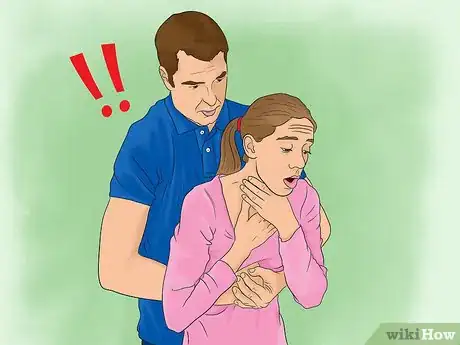

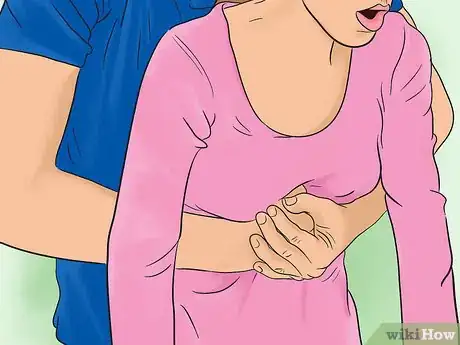
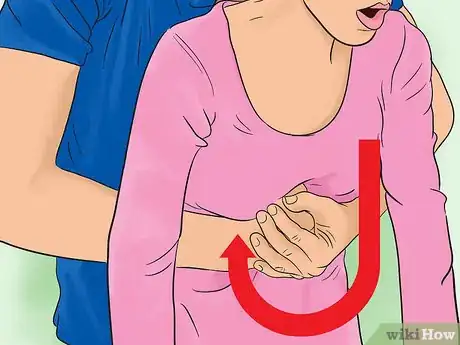



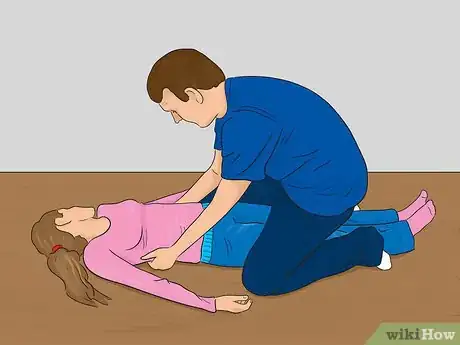
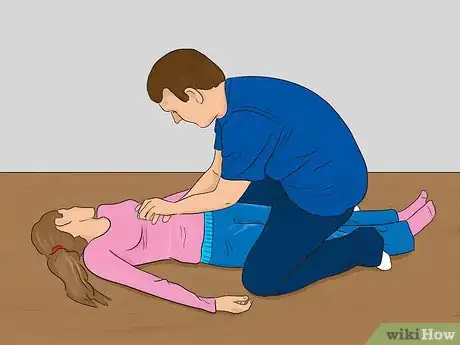
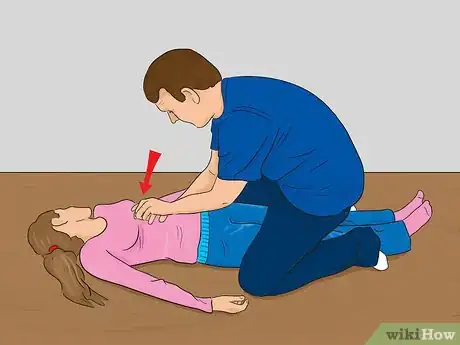





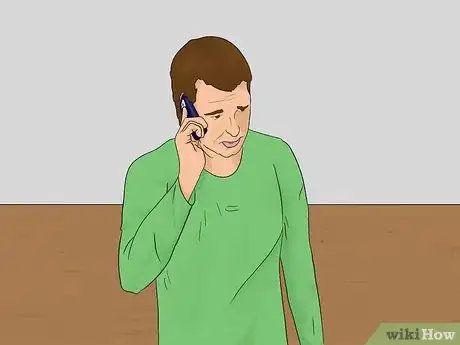




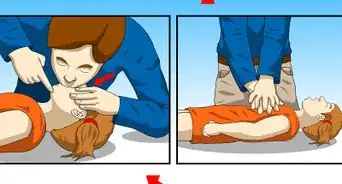
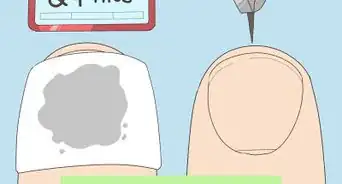


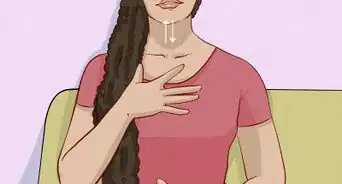



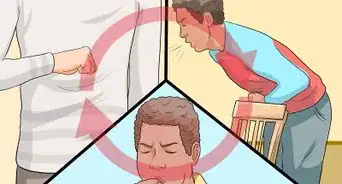














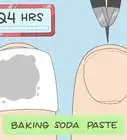






































Medical Disclaimer
The content of this article is not intended to be a substitute for professional medical advice, examination, diagnosis, or treatment. You should always contact your doctor or other qualified healthcare professional before starting, changing, or stopping any kind of health treatment.
Read More...